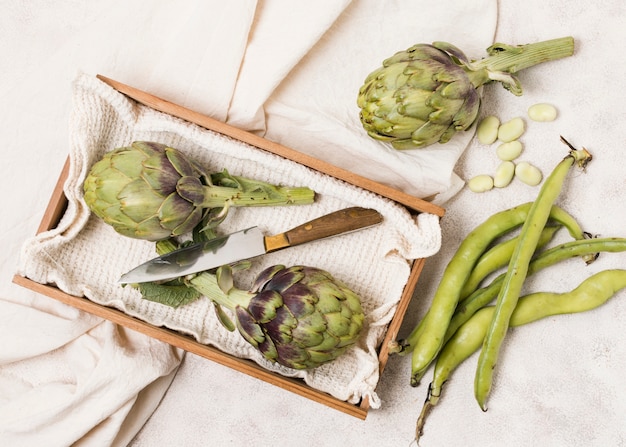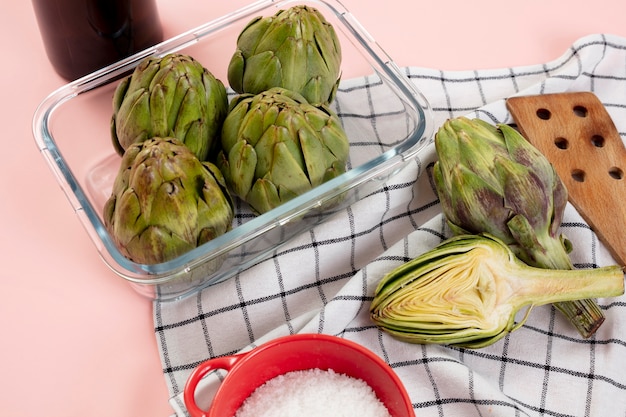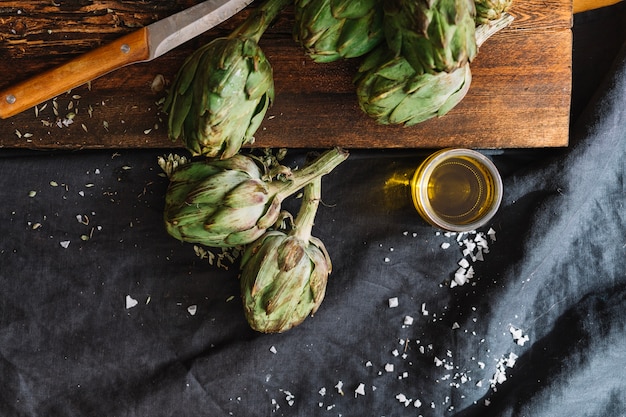Right, let's talk artichokes. These prickly little gems have been a favourite of mine for ages. They're not the easiest thing to prepare, but once you conquer the technique, the reward is truly delicious. From the satisfying "thump" of the knife against those tough outer leaves to the sweet, meaty heart you get to enjoy at the end, there's something oddly satisfying about the whole process. And trust me, once you've mastered the art of cooking artichokes, you'll be showing off your skills at every dinner party.
This guide is your one-stop shop for all things artichoke. We'll dive deep into everything from choosing the perfect artichokes to prepping them, cooking them, and finally, indulging in their unique flavour. So grab your apron, a sharp knife, and a good bottle of wine, and let's get started!
(Part 1) Choosing the Right Artichokes

Finding Your Perfect Artichokes
You know how some people have a knack for picking the best fruits and vegetables? That's me with artichokes! It's all about finding those fresh, plump beauties that are bursting with flavour. I've learned the hard way that not all artichokes are created equal.
- Look for firm, tightly closed buds: These are the freshest ones. If you see an artichoke with open leaves or feels soft to the touch, it's likely past its prime.
- Check the colour: The colour should be a deep, vibrant green with a hint of bluish-grey. If it's a pale green or yellowish, it might be older.
- Feel the leaves: The leaves should be firm, slightly prickly, and have a bit of spring to them.
- Examine the bottom: The bottom of the artichoke should be firm and free of any bruising.
If you can, choose artichokes that have a bit of a silvery green tinge to them. This indicates that they've been harvested at peak ripeness and will be particularly flavourful.
Storing Artichokes
Now, you've got your perfect artichokes, but how do you keep them that way? Artichokes are best stored in the refrigerator, but there are a couple of key things to remember:
- Don't wash them: Washing them too early can lead to them spoiling faster. Wash them right before cooking.
- Wrap them up: Store them in a plastic bag or wrap them in paper towels. This helps keep them moist and prevents them from drying out.
- Refrigerate for up to 5 days: This is the sweet spot for keeping them fresh and delicious.
(Part 2) Prepping the Artichokes

Tools of the Trade:
Now, this is where things get a bit more hands-on, but don't worry, it's not as daunting as it seems. You'll need a few essential tools for tackling those prickly leaves.
- A sharp knife: This is your primary weapon for conquering those prickly leaves. A good chef's knife is ideal, but a sturdy paring knife will also do the trick.
- A large bowl of water: This is your trusty sidekick for soaking the artichokes. It helps remove dirt and grit, giving you a clean slate for cooking.
- A lemon: This is the unsung hero. The citric acid in lemon juice prevents the artichokes from turning brown, keeping them looking fresh and bright.
- A steamer basket: If you plan on steaming your artichokes, a steamer basket is your best friend.
The Trimming Process
Okay, let's get down to the nitty-gritty. Trimming artichokes can be a bit messy, so you might want to wear an apron or an old shirt. Here's a step-by-step guide on how to trim your artichokes:
- Cut off the top: You want to remove the top few inches of the artichoke, including the pointy tips. Think of it like taking the "crown" off. This part is inedible and can be discarded.
- Trim the outer leaves: Use your knife to trim off the tough, outer leaves. You don't have to remove them all, just the ones that are really tough and look like they might be bitter.
- Clean out the choke: This is the fuzzy, hairy part at the base of the artichoke, often called the "choke." It's best to scoop it out with a spoon. Be careful not to damage the heart. The choke can be discarded, or if you're feeling adventurous, you can boil it separately to soften it.
- Cut the base: Cut off the bottom inch or two of the artichoke. This is the hard base that you don't want to eat.
- Soak in lemon water: Once your artichoke is trimmed, soak it in a bowl of water with a squeeze of lemon juice. This helps to prevent it from turning brown.
You can repeat this process for each artichoke you're planning to cook. It might seem like a lot, but once you get the hang of it, you'll be a pro in no time!
(Part 3) Cooking Artichokes

Different Cooking Methods:
Now that your artichokes are prepped, it's time to cook them. There are a few different ways to cook artichokes, each with its own unique flavour profile. Here are a few of my favourites:
Steaming:
This is my go-to method for cooking artichokes. It's simple, healthy, and brings out the artichoke's natural sweetness. Plus, it's a breeze to clean up afterwards.
- Fill a large pot with water: Add a few slices of lemon to the water for extra flavour and to prevent the artichokes from turning brown.
- Place the steamer basket in the pot: Make sure the water is below the bottom of the basket.
- Add the artichokes: Place the artichokes in the steamer basket, ensuring they're not touching. You can steam them whole or cut them in half.
- Steam for 30-45 minutes: The cooking time will vary depending on the size of the artichokes. You'll know they're done when the leaves pull away easily from the heart.
- Serve: Serve them immediately with melted butter, olive oil, or a squeeze of lemon juice.
Boiling:
Boiling artichokes is another easy method. It's a bit faster than steaming, but it can sometimes result in a slightly less tender artichoke.
- Fill a large pot with water: Add a few slices of lemon to the water.
- Bring the water to a boil: Once the water is boiling, add the artichokes. You can boil them whole or cut them in half.
- Boil for 20-30 minutes: The cooking time will vary depending on the size of the artichokes. Check the leaves to see if they pull away easily.
- Serve: Serve them hot with your favourite dipping sauce.
Roasting:
Roasting artichokes adds a delightful smoky flavour to them. It's a fantastic method for bringing out the best of the artichoke's flavour.
- Preheat the oven: Preheat your oven to 400°F (200°C).
- Prepare the artichokes: Cut the artichokes in half and drizzle them with olive oil, salt, and pepper. You can also add other seasonings like garlic powder or herbs.
- Roast for 40-50 minutes: Roast the artichokes until they're tender and slightly browned.
- Serve: Serve them hot with your favourite dipping sauce.
Grilling:
Grilling artichokes adds a unique smoky flavour. It's perfect for a summer barbecue.
- Prepare the artichokes: Cut the artichokes in half or into quarters. Brush them with olive oil, salt, and pepper.
- Grill for 10-15 minutes per side: Grill them over medium heat, flipping them halfway through.
- Serve: Serve them hot with your favourite dipping sauce.
(Part 4) Dipping Sauces for Artichokes
Classic Dipping Sauces:
Let's face it, the real fun begins when you have your cooked artichokes ready to devour! The beauty of artichokes lies in their versatility. They can be enjoyed with a variety of dipping sauces, each adding its own unique flavour. Here are some classic sauces you can try:
- Melted Butter: This is a simple, classic dipping sauce that complements the artichoke's natural flavour. The rich, buttery flavour enhances the artichoke's sweetness.
- Olive Oil and Lemon Juice: This refreshing sauce is perfect for adding a citrusy kick. The tangy lemon juice cuts through the richness of the artichoke and adds a bright, fresh flavour.
- Mayonnaise: A classic and crowd-pleasing option. The creamy texture of mayonnaise provides a luxurious contrast to the artichoke's texture.
- Aioli: A garlic-infused mayonnaise that adds a punch of flavour. The pungent garlic flavour adds a complex dimension to the artichoke's subtle taste.
Creative Dipping Sauces:
But who says you have to stick to the classics? Let's get creative! Here are a few dipping sauces that are guaranteed to impress your guests.
- Roasted Red Pepper Sauce: This sauce is sweet and smoky, with a hint of spice. It pairs perfectly with artichokes. The sweetness of the roasted red peppers complements the artichoke's heartiness, while the smoky flavour adds a depth of complexity.
- Lemon-Dill Sauce: This bright and refreshing sauce is perfect for summertime. The tangy lemon juice and aromatic dill create a light and flavorful sauce that's perfect for artichokes.
- Blue Cheese Sauce: This rich and creamy sauce is perfect for those who like a bit of tang. The strong flavour of blue cheese provides a bold contrast to the artichoke's mild flavour.
- Chorizo Sauce: This spicy and smoky sauce is a great way to add a touch of heat. The spicy chorizo sausage adds a kick to the artichoke's flavour, creating a delicious and satisfying combination.
- Basil Pesto: This vibrant sauce is packed with flavour. It's perfect for adding a touch of Italian flair. The fresh basil, garlic, and pine nuts in pesto create a flavourful sauce that complements the artichoke's texture.
The possibilities are truly endless! Experiment with different flavours and combinations to find your favourite dipping sauce.
(Part 5) Serving Artichokes
How to Eat Artichokes:
Okay, now that your artichokes are cooked to perfection and you've chosen your dipping sauce, let's talk about how to eat them. Eating artichokes can seem a bit intimidating at first, but once you get the hang of it, it becomes a fun and satisfying experience.
- Pull off the leaves: Start with the outer leaves. They're the toughest, so you'll need to pull them off with your fingers.
- Dip and scrape: Dip the base of the leaf into your dipping sauce and then scrape the soft, fleshy part of the leaf against your teeth. You can eat the fleshy part of the leaf, but discard the tough, pointed tip.
- Work your way inwards: As you eat your way inwards, the leaves become softer and more tender.
- Reach the heart: Once you've reached the heart, you can eat it with a fork and knife. It's the most tender and flavorful part of the artichoke.
Some people find it easier to use a knife to cut off the fleshy part of each leaf. But honestly, I prefer the classic "dip and scrape" method. It feels more hands-on and immersive. It's like a little ritual, and it makes the whole experience more enjoyable.
Presentation Matters:
Whether you're serving artichokes as a starter, side dish, or main course, a bit of presentation can go a long way. Here are a few ideas to impress your guests:
- Serve them on a platter: Arrange the artichokes on a beautiful platter, with small bowls of dipping sauces on the side.
- Garnish with herbs: Add a touch of freshness by garnishing the artichokes with chopped parsley, chives, or basil.
- Slice them for easy eating: If you're serving artichokes as a side dish, you can slice them into wedges or quarters for easier eating.
- Serve them with bread: A crusty loaf of bread is the perfect accompaniment to artichokes.
Remember, the presentation is part of the experience. Make it visually appealing, and it'll enhance the enjoyment of your delicious artichokes.
(Part 6) artichoke recipes
Some of my Favourite Recipes:
You might be thinking, "I've got the basics down, now what?" Well, once you've mastered the art of cooking artichokes, it's time to experiment with some exciting recipes that put them centre stage. Here are a few of my favourite recipes that showcase the versatility of this amazing vegetable:
- artichoke and spinach dip: A classic party appetizer, it's packed with creamy goodness and features artichokes as the star ingredient. This dip is a crowd-pleaser, and you can make it even more decadent by adding a sprinkle of parmesan cheese.
- roasted artichokes with Lemon and Garlic: A simple, yet delicious recipe that brings out the best of the artichoke's flavour. The combination of lemon and garlic adds a bright and savory flavour to the roasted artichokes.
- Artichoke and Parmesan Risotto: A luxurious and satisfying dish, perfect for a special occasion. The creamy texture of risotto is a perfect match for the tender artichoke hearts. The addition of parmesan cheese adds a salty and nutty flavour.
- Artichoke and Goat Cheese Salad: A fresh and flavorful salad, perfect for a light lunch or dinner. The tangy goat cheese and the artichokes complement each other beautifully, creating a balanced and flavorful salad.
- artichoke pizza: A creative and delicious pizza topping that will make your taste buds sing. The artichoke hearts add a unique flavour and texture to the pizza, making it a truly satisfying dish.
Remember, don't be afraid to get creative! Experiment with different flavours, spices, and cooking methods to create your own unique artichoke recipes. There are endless possibilities!
(Part 7) Beyond the Basics: The World of Artichokes
Different Types of Artichokes:
You might be surprised to learn that there are different types of artichokes! While the globe artichoke is the most common type, others offer unique flavours and textures.
- Globe Artichokes: The most common type, they have large, prickly heads with thick, fleshy leaves. They have a mild, sweet flavour. This is the type you'll find most often in supermarkets.
- Roman Artichokes: These artichokes are known for their tender hearts and thinner leaves. They have a slightly more intense flavour than globe artichokes. They have a more pronounced artichoke flavour, with a hint of earthiness.
- Cardoon Artichokes: This type of artichoke has a much larger head and a more bitter flavour. It's typically used as a vegetable in stews or salads. The stalks are often used in cooking, adding a unique texture and flavour to dishes.
- Jerusalem Artichokes: These are actually tubers, not true artichokes, but they have a similar flavour. They have a nutty, slightly sweet flavour. Jerusalem artichokes are a good source of inulin, a type of fiber that's good for gut health.
So, if you're feeling adventurous, don't be afraid to explore other types of artichokes. They can add a whole new dimension to your cooking.
Beyond Cooking:
Did you know artichokes can be used for more than just cooking? Here are a few other uses for these versatile plants.
- As a natural remedy: Artichokes have been used in traditional medicine for centuries. They are known for their digestive benefits and can also help to lower cholesterol levels. They are also a good source of antioxidants, which can help protect your cells from damage.
- In cosmetics: Artichoke extracts are used in some cosmetics, as they are said to have antioxidant and anti-aging properties. They help to improve skin elasticity and reduce the appearance of fine lines.
- As a decorative element: Artichokes can be used in floral arrangements and other decorative displays. They add a unique texture and visual interest to any setting.
(Part 8) FAQs
Q: What's the best way to store artichokes?
A: Artichokes should be stored in the refrigerator for up to 5 days. Don't wash them before storing; wash them right before cooking. Wrap them in a plastic bag or paper towels to keep them moist.
Q: How do I know when an artichoke is cooked?
A: You'll know an artichoke is cooked when the leaves pull away easily from the heart. You can also test the heart with a fork. It should be tender.
Q: What should I do if I don't like the "choke"?
A: You can boil the choke separately for 15-20 minutes to soften it. It's not as palatable as the heart but some people enjoy its nutty flavour. Otherwise, you can simply discard it.
Q: Can I freeze artichokes?
A: Yes, you can freeze artichokes. However, it's best to freeze them after cooking. You can freeze them whole or cut into quarters. Make sure to blanch them for 3-5 minutes before freezing to prevent them from browning. Frozen artichokes can be used in soups, stews, or dips.
Q: What are some other ways to use artichokes?
A: Artichokes are extremely versatile. They can be used in a variety of dishes, including salads, pizzas, pastas, soups, and dips. You can also grill them, roast them, or even fry them. Be creative and experiment with different flavours and combinations!
Everyone is watching

Prime Rib Roast Cooking Time Chart: Per Pound Guide
Cooking TipsPrime rib roast. Just the name conjures images of lavish dinners, crackling fires, and hearty laughter. It’s ...

How Long to Bake Potatoes in the Oven (Perfect Every Time)
Cooking TipsBaked potatoes are a staple in my kitchen. They're incredibly versatile, delicious, and surprisingly easy to m...

Perfect Rice Every Time: The Ultimate Guide to Cooking Rice
Cooking TipsAs a self-proclaimed foodie, I've always been a bit obsessed with rice. It's the foundation of countless cuisi...

The Ultimate Guide to Cooking Asparagus: Tips, Techniques, and Recipes
Cooking TipsAsparagus. The mere mention of this spring delicacy conjures up images of vibrant green spears, crisp and burs...

Ultimate Guide to Cooking the Perfect Thanksgiving Turkey
Cooking TipsThanksgiving. Just the word conjures up images of overflowing tables laden with delicious food, the scent of r...
